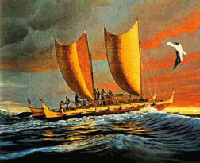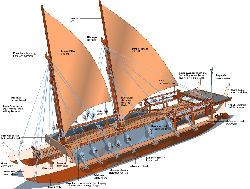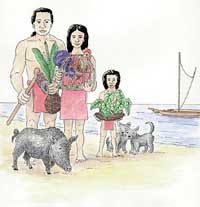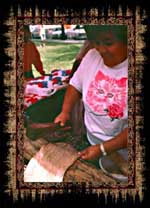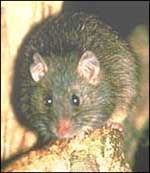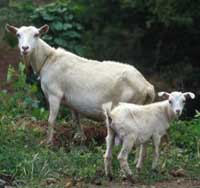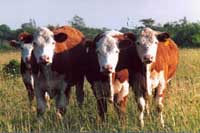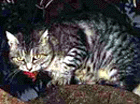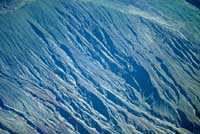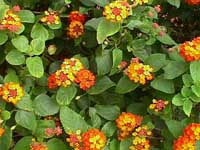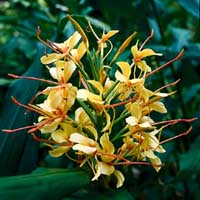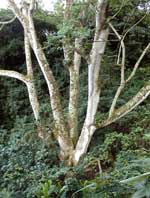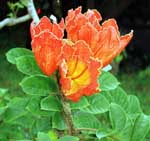

Hawaii's Species of
Greatest Conservation Need
Flora
Fauna

Native Hawaiian
Forest Bird Videos

|
The Arrival of Humans
|
|
A) Marquesans and Tahitians |

|
The first people arrived to Hawaii from the Marquesas Islands about 1,600 years ago, in approximately 400 AD.
They arrived in double hulled canoes after travelling 2,400 miles across the open ocean without any navigational equipment. They navigated using stars, ocean currents and swells, bird flights and wind direction.
The first canoe is believed to have landed on the windward coast of Oahu. |
|
their impact on the environment |
Polynesians began the process of man-made change in Hawai'i.
The need for food, clothing, shelter and transportation affected native resources. |
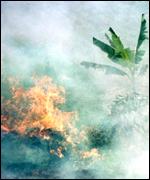 |
a.) They cleared land to grow alien plants. They practiced slash and burn agriculture, a very destructive type of agriculture which caused many plant species' extinctions.
b.) They found at least 17 varities of flightless birds in Hawaii which they hunted and ate into extinction. |
 |
 |
c.) They captured millions of birds and plucked them to make feather capes, cloaks, helmets, god images and leis. Feathers were the most valuable commodity in ancient Hawaii. Countless small honeycreepers were killed so their red and yellow feathers could adorn rulers' feather robes and headdresses. 80,000 birds of one now-extinct species were sacrificed to make one of King Kamehameha I's cloaks in the late 1700s. Many of the birds also were eaten after being plucked. Smithsonian paleoarchaeologists discovered these birds' fossilized remains on Oahu, Kauai, Molokai and Maui and were able to prove that Hawaiians had destroyed one-half of the native land bird species formerly occupying these islands. |
 |
 |
d.) Their homes were constructed from plant materials.
The native pili grass, plentiful on all islands, was the favored material for thatching.
e.) Sturdy forest trees were cut to build canoes |
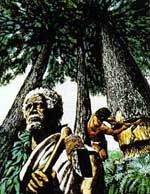 |
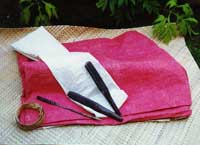 |
f.) Barkcloth was the fabric for Hawaiian clothing. Not woven like most textiles, tapa cloth is made from strips cut from the bark of the paper mulberry tree that are flattened with special mallets. Many strips can be sewn or glued together with a plant resin to create a large sheet of fabric. The thin paper-like material can be painted or printed with natural pigments, applied with brushes or bamboo stamps. Hawaiians also used the leaves and fibers of plants, both alien and native, to make sandals and protective "raincoats" and for many other purposes. |
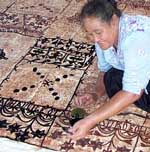 |
|
g.) With the arrival of humans paradise was lost. But the biggest threat for the native ecosystem wasn't even the humans - at least not directly. The real enemies were the newly introduced plants and animals. This indirect impact was a sudden alien invasion for the native species that they were not prepared for. Many native species became extinct because they were unable to successfully cope with the numerous aggressive introduced species.
|
Early Polynesian settlers traveled with what was necessary for their survival during the long trip and in their new home. Provisions were carefully selected and packed to insure a successful journey and settlement in a new home.
Their canoes carried 20-25 people, along with their many important plant and animal species which the ancestors of these people had been cultivating in the Western and Central Pacific for several thousand years. They brought animals and plants that provided food, shelter, clothing, and medicine or were used in religious practices: |
Food
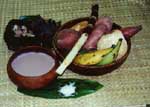 |
The alien animals and plants brought by the Polynesians provided a complete and healthy diet. Their plants included breadfruit, bamboo, paper mulberry (from which they made their clothing), gourd plants, hau, ti, kukui nut, kamani, kava, kou, milo, sugar cane, mountain apple, and ginger. Water from coconut was tasty and satisfying. Sugarcane and banana were enjoyed while yam and sweet potato were the starches in their diets.
Taro, was the most important crop in old Hawai'i. It was associated with the powers of the gods Kane and Lono and provided important food nutrients to Hawaiians. Growing taro and preparing poi was a community activity that supported important cultural values. This plant was central to the Hawaiian lifestyle in many ways.
Meat came from pigs, dogs and chicken.
(For centuries in Hawaii, only the men could cook and eat roasted pig, which was one of the sacred foods offered in sacrifice to Hawaiian male gods. A woman could be put to death for eating such forbidden foods. Eventually, the practice ended, but not until the early 1800s during the reign of Kamehameha II.) |
Shelter
Hawaiians used the leaves of coconut (nui) and hala (pandanus) for their houses.
Clothing
The first settlers planted wauke (paper mulberry) and other plants used to prepare tapa (barkcloth). Hawaiian tapa is praised for its fine texture, design and color.
Medicine
Many of the plants brought by the Polynesians were used as medicine. These include kukui, noni, coconut, taro, breadfruit, banana, sugarcane, kava and others. Hawaiians also made medicines from the many native plants and seaweeds abundant in the islands.
Other needs
Some Polynesian plants had religious importance as offerings, within ceremonies or in the making of sacred images. Plants were also used for musical instruments, cordage, adornment, tools, and amusements. |
|
Hawaiians also brought some new species with them unintentionally:
They introduced flies, head lice and the polynesian rat which multiplied rapidly and climbed into the trees to eat native bird eggs and nestlings. These rats also ate the fruits and seeds of native plants causing reproductive failure.
|
By the time of Cooks arrival over 300,000 Hawaiians were living on these islands and they had a severe impact on the native flora and fauna.
|
|
B) The European and American impact |
a) Alien Animals
The Europeans and Americans, beginning with Captain Cook, brought cows, sheep, goats, pigs, horses and deer to Hawaii's rainforests which had plants and trees without thorns, poisons or bad taste because these native species never had any animals eating them. These introduced herbivores were left to roam the mountains and they became wild and their populations exploded. |
|
Europeans also introduced two more rat species the norway rat and roof rat. Both of these are serious bird predators. They are excellent swimmers, adept at island hopping. They spread rapidly colonizing the farthest reaches of the islands and caused incalculable damage to the native birdlife. The mongoose was introduced by the Sugar Cane growers to eat the rats but they too have become serious bird predators. House cats which have been released into the wild also eat the native Hawaiian Honeycreepers. (Cats are estimated to kill about 200 million birds in the world each year.) |
|
In 1827 a whaling ship, the Wellington, arrived to Maui from Mexico with mosquito larvae in their water barrels. After dumping this water in Lahaina, mosquitos were introduced to Hawaii. These insects bit chickens which carried avian malaria and then the same infected mosquitos bit the native Hawaiian Honeycreepers, which had no immunity to the disease. The native birds died within several days of being bitten. The birds were also suffering from an introduced pox disease. Today the surviving native honeycreepers live above 4000 feet elevation where the prevalence of avian malaria is not as great because the mosquitos don't like the colder temperature. |
|
In order to replace the Hawaiian honeycreepers and to fill a bird void in the coastal areas after the extinctions occurred, Hui Manu or bird groups formed. Over 200 species of non-native birds were brought to Hawaii and released. Many of these species died out but a lot survived that now compete with the native honeycreepers causing them to decline as well. |
b.) Humans
People removed sandalwood (from 1795-1830) and they cut their firewood and housebuilding lumber from the mountains.
The people and wild introduced herbivores destroyed many areas of Hawaiian native forests. By 1850 severe erosion developed which caused loss of top soil, siltation of the coral reefs and depletion of groundwater supplies. |
c.) Alien Plants
In 1850 Sugar Planters and foresters began a 150 year effort to reforest Hawaii's destroyed watershed vegetation. They brought in millions of foreign trees from all over the world to plant here. Over 200 species were introduced. These foreign trees caused further native plant extintions by outcompeting the native varities for space, light, and nutrients. |
|

